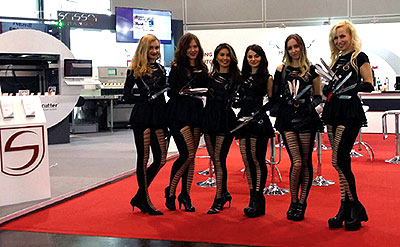It is commonly believed that bottlenecks in print production most often occur in the bindery. But, to reach the finish line, let’s look back at the start. While the finishing may be the most time-consuming stage, what other factors consequently affect the time it takes for print jobs to reach the bindery where the cutter operator is forced to make up for any lost time?
Many print service providers invest in the latest prepress and cutting machines to produce high-quality products at record speeds, yet fail to consider how to pass the baton to finishing. Even the most advanced equipment requires a skilled journeyman who can fluidly manage the production timeline. Implementing an efficient workflow between prepress and press can vastly improve post-press production times and quality of the finished product.
Bottlenecks eliminated at OvernightPrints.com
As the founder of OvernightPrints.com, a leading e-commerce printer of business cards, postcards, brochures and other printed materials, Brett Heap originally founded Opensoft Inc. to directly solve his own printing issues. The drive to maximize the efficiency of guillotine cutters at his production facilities in the US and Germany led to development of software that would improve function and reduce errors.
“In the beginning, (Overnight Prints) wasted a lot of paper. Run sheets would have empty positions because they needed to get printed and out the door,” said Paul Barnum, COO, OvernightPrints.com. “Brett (Heap) has always driven everything toward eliminating waste and reducing the cost.”
Under Heap’s direction, the production facility programmed prerecorded cutting routines into several Itotech guillotine cutters. Manual adjustments by cutter operators, however, would inadvertently change the cut courses and naming conventions of the cutting routines, resulting in inaccurate cuts.
To eliminate errors and reduce waste, Heap moved to connect the machines and automate the process. After consulting the manufacturer, the machines were rewired to enable broadcast signals between them. Engineers then were hired to write programs for the cutters, and that software would eventually become Scissor Hands.
“We had to reverse engineer the signaling of the cutters to figure out how to tell the machine the next cutting course,” Barnum explained.
Software adds cutting efficiency
Scissor Hands demonstrates how a single software solution can effectively reduce production and labor costs on gang runs. Created to optimize guillotine cutting and maximize overall print production, the cutting automation software was conceptualized for internal use in 2012 at Overnight Prints, but the technology had implications for the print industry as a whole.
The enhanced JDF automation works by creating efficient cut sequencing based on a run’s prepress JDF data, sheet count, substrate coatings and packaging intent. Barcodes are added to the press sheet from which the software reads the job. Once scanned, the software displays the live image of the job, calculates the most efficient sequence of cuts and loads that sequence into the cutting machine in fractions of seconds.
Unlike previous methods, the automatic job loader also saves a tremendous amount of time by eliminating the need for the operator to search for a specific cutting routine. Instead of storing hundreds of cutting courses, Scissor Hands customizes each print job.
“Every time a new press sheet is built, the information goes to the machine, and it’s specific to that job. We could save the routine, but we don’t need to anymore because it acts like a new job every time,” said Barnum.
The software adds artificial intelligence (AI) to guillotine cutters. These AI-created cut programs share cuts across lifts to reduce the total number of cuts needed to finish an entire run. Shorter, smarter cut programs reduce blade wear and extend the longevity of the cutting equipment, ultimately saving time and money on maintenance and upkeep.
Job runs simplified for operators
Labor costs are another demonstrable cost savings for production facilities that implement the print cutting automation into their workflow. While some manufacturers of similar systems display cut measurements as line drawings, Scissor Hands shows the actual product image onscreen with step-by-step animation of cutting each step from start to finish without having to calculate, enter dimensions or adjust by numbers or visual observation. Operators just follow the presentation for how to load and rotate the lift.
The efficiency of the provided algorithm, combined with guided animation, allow for entry-level labor to complete print jobs, which significantly reduces the need for experienced journeyman. Additionally, operator training time can be condensed.
Some of the most experienced cutters at Overnight Prints shared that the software would save 20 minutes of every hour in cutting time alone. Operators no longer need to waste significant time calculating, doing decimal conversions or planning cut courses before they begin cutting.
An integrated MIS system provides real-time reporting. It can track the name of the employee completing the print job, start and stop times, blade drops and other relevant data.
Awarded a 2015 Must See ‘Ems Award, Scissor Hands was named a leading innovation in cutting edge automation by a panel of industry experts at GRAPH EXPO 15.
Zeenath Haniff is the content writer for Farheap Solutions, Las Vegas, Nevada. Scissor Hands uses artificial intelligence to augment a cutter’s behavior. The cloud-based auxiliary system only requires the installation of a mounted touchscreen, barcode scanner and model-specific connector to enjoy the benefits of newer imposition software on older equipment that are not fully computerized. Scissor Hands can work with any cutter that has a programmable back gauge. For more information, visit scissorhands.net.
Source: http://www.postpressmag.com/stories/120916/labor-reduction-technology.shtml

